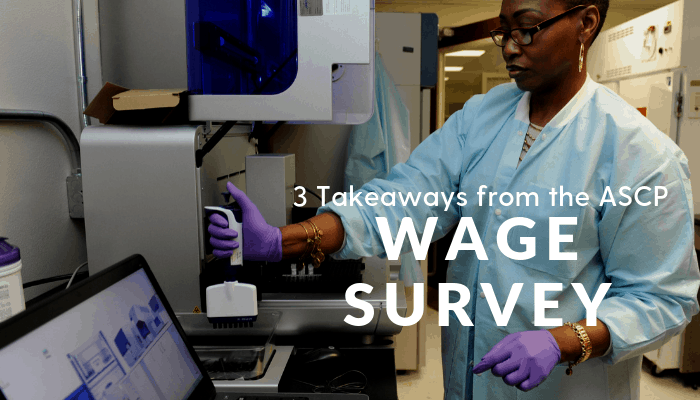In early October 2018, the American Journal of Clinical Pathology published the findings of a 2017 wage survey conducted in partnership with the American Society for Clinical Pathology, designed to provide a window into trends in compensation among lab employees. In case you aren’t a regular subscriber to the AJCP, here are the highlights and 3 key takeaways:
1. Wages are up for everyone (well, almost everyone)
For salaried employees, wages increased for all ASCP-licensed positions except for Histotechnologists (HTL), Microbiologists (MB) and Pathologist Assistants (PA). For hourly employees, wages increased for all professionals except for Histotechnologists (HTL). The biggest wage increases were seen by Phlebotomists (PBT) and Lab Assistants (CLA/MLA), which is unsurprising given the current record-low unemployment rates across the entirety of the labor force. However, Cytotechnologists (CT) also saw large increases in their pay between 2015 and 2017, owing in part to an increase in demand for services that is the result of a a rapidly aging workforce. Somewhat surprisingly, wages for MTs and MLTs only rose 2.15% when adjusted for inflation.
2. It pays to live in the city (or does it?)
Clinical lab employees working in more dense, urban environments earned more than their counterparts working in rural areas. However, this survey does not account for cost of living comparisons, or adjust for those differences. A job in the city may pay more, but you may have less in the piggy bank at the end of the month. The devil is in the details – cost of transportation, food, utilities, taxes, and housing may all cost comparatively more in an urban environment.
3. Stay in it to win it (and think about going back to school)
Unsurprisingly, statistically speaking, those with the most experience in the clinical lab made the most in 2017. However, pay increases for experience – while consistent across all lab roles – are more pronounced in some positions than in others. For example, Medical Lab Scientists (MLS/MT/CLS) with 15+ years of experience made, on average, 20% more than scientists with less than 5 years of experience. Yet, Cytogenetic Technologists (CG) with 15+ years of experience in the lab saw less than 5% more pay than their less experienced peers. One consistent truth in the survey data is that it pays to get a 4-year degree. Those professionals with 4-year degrees consistently out-earned those with 2-year degrees or less, even when the latter possessed decades more experience in the lab.
Conclusion:
Make sure to take any wage survey with a grain of salt. While there are some interesting data points, results like this are heavily dependent on collection methodology and the accuracy of self-reported wages. However, the published data does reflect the broad trends that we have seen in the lab industry as of late. If you’re a clinical lab professional who is not sure if you are earning as much as you could be, or an employer unsure if your facility’s wages are competitive, contact us at Lighthouse Lab Services, and we’ll be happy to provide you a free assessment.
For more info, and to read the full report, visit the American Journal of Clinical Pathology report summary here.

I do not feel my wages have increased for the demand and difficulty to find educated employees with work experience in Medical Technology with 4 year degree and MLS(ASCP) certification. I do not see the respect from upper management nor the desire to make sure I have job satisfaction. I do not mean treating me like a princess I mean noticing that I actually matter and that they know my name…until I put one foot out of place…then they are on me like glue. My immediate supervisor is pretty great and that is why I stay. She cares and likes to hear if I have a concern or practical need.